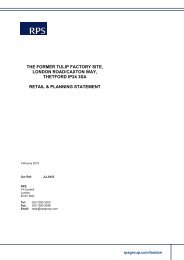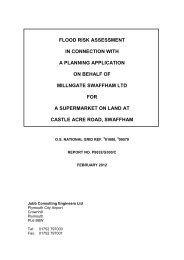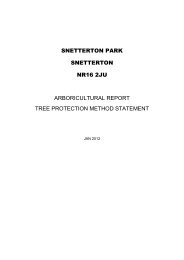HERITAGE STATEMENT ST PETERS CHURCH THETFORD For THETFORD COUNCIL
Heritage%20Statement%20February%202013.pdf
Heritage%20Statement%20February%202013.pdf
You also want an ePaper? Increase the reach of your titles
YUMPU automatically turns print PDFs into web optimized ePapers that Google loves.
But Thetford’s fortunes were to be short-lived as it gave way to competition from other growing<br />
towns, especially King’s Lynn and Norwich. The cathedral and bishop moved to Norwich in<br />
1094 and the castle seems to have been demolished, at least in part, by 1173. To the south of the<br />
castle, the market place was established, in the area currently occupied by Old Market Street and<br />
<strong>For</strong>d Street.<br />
Monastic precincts expanded to fill the gap, with the founding of St Mary’s Cluniac Priory to the<br />
west of the town. By the fourteenth century, a modest population of 1,500 was supporting five<br />
monastic houses and 20 parish churches. Only three of those churches survive today – St Peter, St<br />
Cuthbert and St Mary the Less.<br />
The medieval town was mainly on the north bank of the river Thet. As well as blocks laid out<br />
between Nether Row and Pike Lane, there was a further core of buildings round the White Hart<br />
Street, Minstergate and King Street junction.<br />
Decline and revival<br />
The dissolution of the monasteries caused the collapse of Thetford’s already precarious economy,<br />
and the population dwindled further. Recovery began in the late seventeenth century, with the<br />
river made navigable to connect to King’s Lynn; the riverside tow path was improved and the<br />
adjacent water meadows were drained and cultivated. Commercial trade on the river provided the<br />
main source of income for Thetford’s town Corporation and formed the basis for corn milling,<br />
malting and brewing, as well as tanning and paper and pulp milling. The main employer in the<br />
town was Burrell Engineering, established in 1770 as makers of steam traction engines and other<br />
agricultural machinery.<br />
The late eighteenth century and early nineteenth century saw much rebuilding and consolidation<br />
in Thetford, but almost wholly on the lines of the medieval, or even Saxon streets. In 1786 the<br />
market place moved to its present day position, on the old Grassmarket. The Guildhall was<br />
reconstructed (and rebuilt again in 1901). White Hart Street and Bridge Street were busy with<br />
turnpike traffic from London to Norwich and had three coaching inns – the anchor, Bell and<br />
White Hart. Some of the older timber framed buildings in the town were re-fronted in the<br />
fashionable grey gault brick; later on, after the coming of the railway in 1845, imported red brick<br />
became the norm.<br />
By 1818, Thetford had enough confidence to promote a spa and riverside promenade, laid out by<br />
John Burrell Faux. It was not a commercial success and the pump room closed after twenty years,<br />
but Spring Walk, to the west of Nun’s Bridges, is a reminder of the venture and remains an<br />
appealing path alongside the Little Ouse.<br />
Twentieth Century Thetford<br />
At the start of the twentieth century Thetford was a modest market town, supported by its<br />
brewing, malting and engineering industries. The closure of Burrell Engineering in 1929 had a<br />
catastrophic effect, creating more than 500 redundancies, and over the next ten years the<br />
population dropped by a quarter, to around 3,000 people. The second world war air bases brought<br />
some economic stability, but by 1952 Thetford faced yet more decline. To make matters worse,<br />
the town had one of the worst sewer and drainage systems in the country, with no immediate<br />
prospect for its replacement.<br />
Thetford Borough Council saw that new homes and jobs were essential if the town was to be kept<br />
alive. Accordingly, the Council established a Town Development Committee and applied to the<br />
London County Council for an expansion (London overspill) programme. The proposals were<br />
eventually approved in 1957 and the first new residents moved into their new homes in April<br />
1959.














